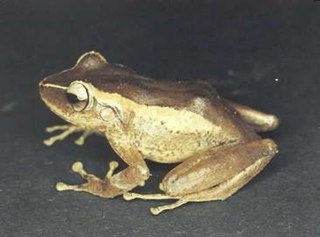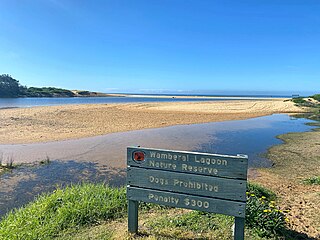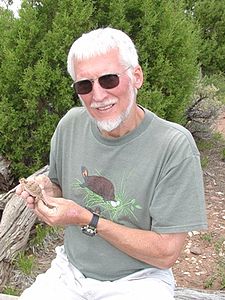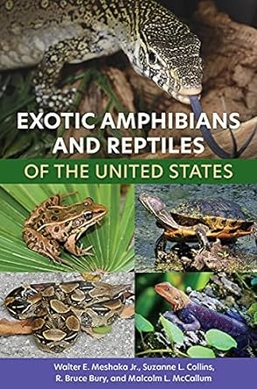
The Holocene extinction, or Anthropocene extinction, is the ongoing extinction event caused by humans during the Holocene epoch. These extinctions span numerous families of plants and animals, including mammals, birds, reptiles, amphibians, fish, and invertebrates, and affecting not just terrestrial species but also large sectors of marine life. With widespread degradation of biodiversity hotspots, such as coral reefs and rainforests, as well as other areas, the vast majority of these extinctions are thought to be undocumented, as the species are undiscovered at the time of their extinction, which goes unrecorded. The current rate of extinction of species is estimated at 100 to 1,000 times higher than natural background extinction rates and is increasing. During the past 100–200 years, biodiversity loss and species extinction have accelerated, to the point that most conservation biologists now believe that human activity has either produced a period of mass extinction, or is on the cusp of doing so. As such, after the "Big Five" mass extinctions, the Holocene extinction event has also been referred to as the sixth mass extinction or sixth extinction; given the recent recognition of the Capitanian mass extinction, the term seventh mass extinction has also been proposed for the Holocene extinction event.

Herpetology is a branch of zoology concerned with the study of amphibians and reptiles. Birds, which are cladistically included within Reptilia, are traditionally excluded here; the separate scientific study of birds is the subject of ornithology.

Conservation biology is the study of the conservation of nature and of Earth's biodiversity with the aim of protecting species, their habitats, and ecosystems from excessive rates of extinction and the erosion of biotic interactions. It is an interdisciplinary subject drawing on natural and social sciences, and the practice of natural resource management.

Habitat conservation is a management practice that seeks to conserve, protect and restore habitats and prevent species extinction, fragmentation or reduction in range. It is a priority of many groups that cannot be easily characterized in terms of any one ideology.

Since the 1980s, decreases in amphibian populations, including population decline and localized mass extinctions, have been observed in locations all over the world. This type of biodiversity loss is known as one of the most critical threats to global biodiversity. The possible causes include habitat destruction and modification, diseases, exploitation, pollution, pesticide use, introduced species, and ultraviolet-B radiation (UV-B). However, many of the causes of amphibian declines are still poorly understood, and the topic is currently a subject of ongoing research.

Chytridiomycosis is an infectious disease in amphibians, caused by the chytrid fungi Batrachochytrium dendrobatidis and Batrachochytrium salamandrivorans. Chytridiomycosis has been linked to dramatic population declines or extinctions of amphibian species in western North America, Central America, South America, eastern Australia, east Africa (Tanzania), and Dominica and Montserrat in the Caribbean. Much of the New World is also at risk of the disease arriving within the coming years. The fungus is capable of causing sporadic deaths in some amphibian populations and 100% mortality in others. No effective measure is known for control of the disease in wild populations. Various clinical signs are seen by individuals affected by the disease. A number of options are possible for controlling this disease-causing fungus, though none has proved to be feasible on a large scale. The disease has been proposed as a contributing factor to a global decline in amphibian populations that apparently has affected about 30% of the amphibian species of the world. Some research found evidence insufficient for linking chytrid fungi and chytridiomycosis to global amphibian declines, but more recent research establishes a connection and attributes the spread of the disease to its transmission through international trade routes into native ecosystems.

James Ray Dixon was professor emeritus and curator emeritus of amphibians and reptiles at the Texas Cooperative Wildlife Collection at Texas A&M University. He lived in El Campo, Texas, throughout most of his childhood. He published prolifically on the subject of herpetology in his distinguished career, authoring and co-authoring several books, book chapters, and numerous peer reviewed notes and articles, describing two new genera, and many new species, earning him a reputation as one of the most prominent herpetologists of his generation. His main research focus was morphology based systematics of amphibians and reptiles worldwide with emphasis on Texas, US, Mexico, Central America, and South America, although bibliographies, conservation, ecology, life history and zoogeography have all been the subjects of his extensive publications.
Hobart Muir Smith, born Frederick William Stouffer, was an American herpetologist. He is credited with describing more than 100 new species of American reptiles and amphibians. In addition, he has been honored by having at least six species named after him, including the southwestern blackhead snake, Smith's earth snake, Smith's arboreal alligator lizard, Hobart's anadia, Hobart Smith's anole, and Smith's rose-bellied lizard. At 100 years of age, Smith continued to be an active and productive herpetologist. Although he published on a wide range of herpetological subjects, his main focus throughout his career was on the amphibians and reptiles of Mexico, including taxonomy, bibliographies, and history. Having published more than 1,600 manuscripts, he surpassed all contemporaries and remains the most published herpetologist of all time.

Dendropsophus branneri is a small hylid tree frog endemic to the Atlantic Forest region of Brazil. It feeds mainly on arthropods and is preyed upon by various invertebrates and vertebrates. Although currently classified by the IUCN Redlist as "least concern", D. branneri suffers rapid habitat loss due to residential development, agriculture, logging, and clearing for pastureland. Male D. branneri are noted for their fighting call, which differs significantly in frequency, duration, and pulses per call compared to their mate advertisement call. Males are also noted for their willingness to escalate physical altercations against other males, which includes kicking, pushing, and wrestling their opponent into non-dominant positions. Unlike most other frog species, D. branneri can breed in both temporary and permanent pools allowing it to inhabit a wide variety of habitats leading to its wide distribution.

Eleutherodactylus portoricensis is a frog native to Puerto Rico that belongs to the family Eleutherodactylidae. Its vernacular English names are upland coqui, mountain coqui, and Puerto Rican robber frog. The species’ range spans the Luquillo Mountains of northeastern Puerto Rico and the Cordillera Central, which forms the highland “backbone” of Puerto Rico and includes an eastern extension beginning at the city of Cayey. However, the species is likely extirpated from the western Cordillera Central.

The golden toad is an extinct species of true toad that was once abundant in a small, high-altitude region of about 4 square kilometres (1.5 sq mi) in an area north of the city of Monteverde, Costa Rica. It was endemic to elfin cloud forest. Also called the Monte Verde toad, Alajuela toad and orange toad, it is commonly considered the "poster child" for the amphibian decline crisis. This toad was first described in 1966 by herpetologist Jay Savage. The last sighting of a single male golden toad was on 15 May 1989, and it has since been classified as extinct by the International Union for Conservation of Nature (IUCN).
Martha L. "Marty" Crump is a behavioral ecologist in the Department of Biology and the Ecology Center at Utah State University who studies amphibians and reptiles. Crump was the first individual to perform a long-term ecological study on a community of tropical amphibians, and did pioneering work in the classification of variability in amphibian egg size as a function of habitat predictability. She has co-authoried one of the most popular modern herpetology textbooks, Herpetology (1997–2015) as well as the memoir In Search of the Golden Frog (2000) and a number of other books for both adults and children. In 1997, she received the Distinguished Herpetologist Award from The Herpetologists’ League.

Wamberal Lagoon, an intermittently closed intermediate saline coastal lagoon, is located on the Central Coast region of New South Wales, Australia. Wamberal Lagoon is located between the beachside settlements of Forresters Beach and Wamberal, and adjacent to the Pacific Ocean, about 87 kilometres (54 mi) north of Sydney.

Stanley E. Trauth is an American herpetologist and professor of zoology and environmental studies at Arkansas State University. He is also the curator of the herpetological collection of the Arkansas State University Museum of Zoology.
Walter E. Meshaka Jr. is an American herpetologist and natural historian. He was the supervisory curator for the four National Parks in southern Florida from 1995 to 2000. In 2000 he became the Senior Curator of Zoology and Botany at the State Museum of Pennsylvania in Harrisburg, Pennsylvania. His research has been covered by Lawrence Journal-World, among other news outlets.
Joseph Thomas Collins, Jr. was an American herpetologist. A graduate of the University of Cincinnati, Collins authored 27 books and over 300 articles on wildlife, of which about 250 were on amphibians and reptiles. He was the founder of the Center for North American Herpetology (CNAH). He died while studying amphibians and reptiles on St. George Island, Florida on 14 January 2012. "For 60 years I was obsessed with herpetology," Joe Collins claimed.
C. Kenneth Dodd Jr., is an American herpetologist and conservationist. He earned his Ph.D. under Edmund D. Brodie Jr. from Clemson University in 1974. From 1976 to 1984 he worked in the research division of the U.S. Fish and Wildlife Service, then he transferred to the U.S. Geological Survey in 1984, where he remained until his retirement in 2007. He is currently Courtesy Associate Professor in the Department of Wildlife Ecology and Conservation, University of Florida and an Affiliate of the Florida Museum of Natural History. He has published over 200 papers, reviews and books. Much of his research focuses on turtle and amphibian ecology/conservation. He, along with R. Bruce Bury and Garry Fellers were the first to suggest widespread amphibian declines were progressing. He is a nationally recognized herpetologist.
Conservation paleobiology is a field of paleontology that applies the knowledge of the geological and paleoecological record to the conservation and restoration of biodiversity and ecosystem services. Despite the influence of paleontology on ecological sciences can be traced back at least at the 18th century, the current field has been established by the work of K.W. Flessa and G.P. Dietl in the first decade of the 21st century. The discipline utilizes paleontological and geological data to understand how biotas respond to climate and other natural and anthropogenic environmental change. These information are then used to address the challenges faced by modern conservation biology, like understanding the extinction risk of endangered species, providing baselines for restoration and modelling future scenarios for species range's contraction or expansion.
Leticia "Letty" E. Afuang is a Filipina biologist and wildlife conservationist currently working as a professor under the Animal Biology Division of the Institute of Biological Sciences (IBS) at the University of the Philippines Los Baños (UPLB), located in the Philippine province of Laguna. She is also one of the main curators for the Zoological and Wildlife Collection at the UPLB Museum of Natural History. While known as the "Snake Lady," her research as a herpetologist also focuses on other reptiles, amphibians and a wide array of herpetofauna across the Philippine islands. As an advocate for environmental sustainability, she has founded multiple organizations such as the Mindoro Biodiversity Conservation Foundation and the Biodiversity Conservation Society of the Philippines.

Exotic Amphibians and Reptiles of the United States is a field guide to the exotic amphibians and reptiles established in the continental United States and Hawaii. It is co-authored by herpetologists Walter E. Meshaka Jr., Suzanne L. Collins, R. Bruce Bury, and Malcolm L. McCallum.














